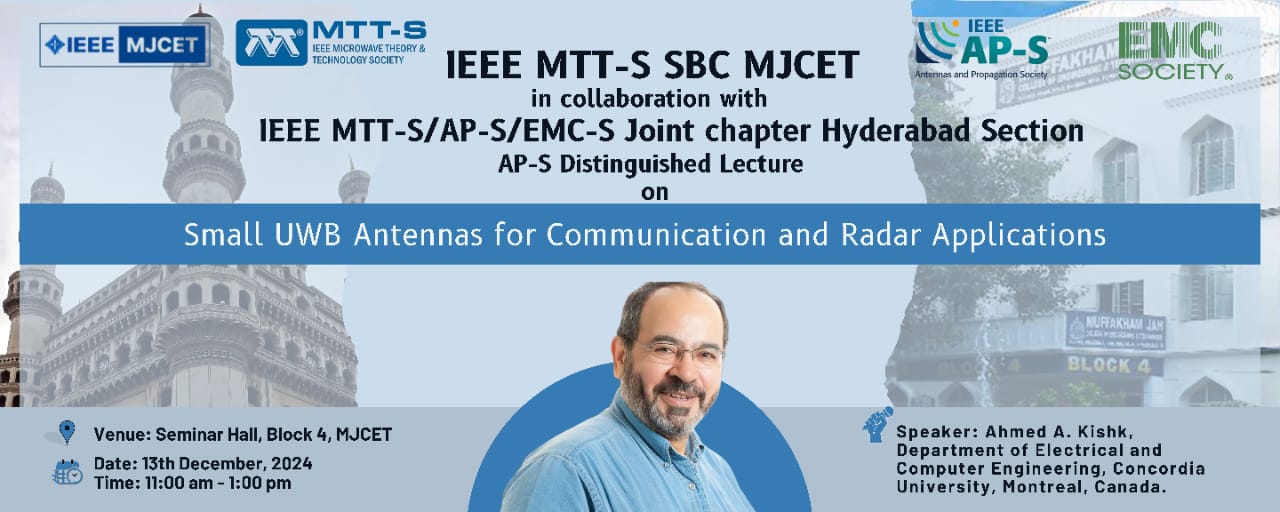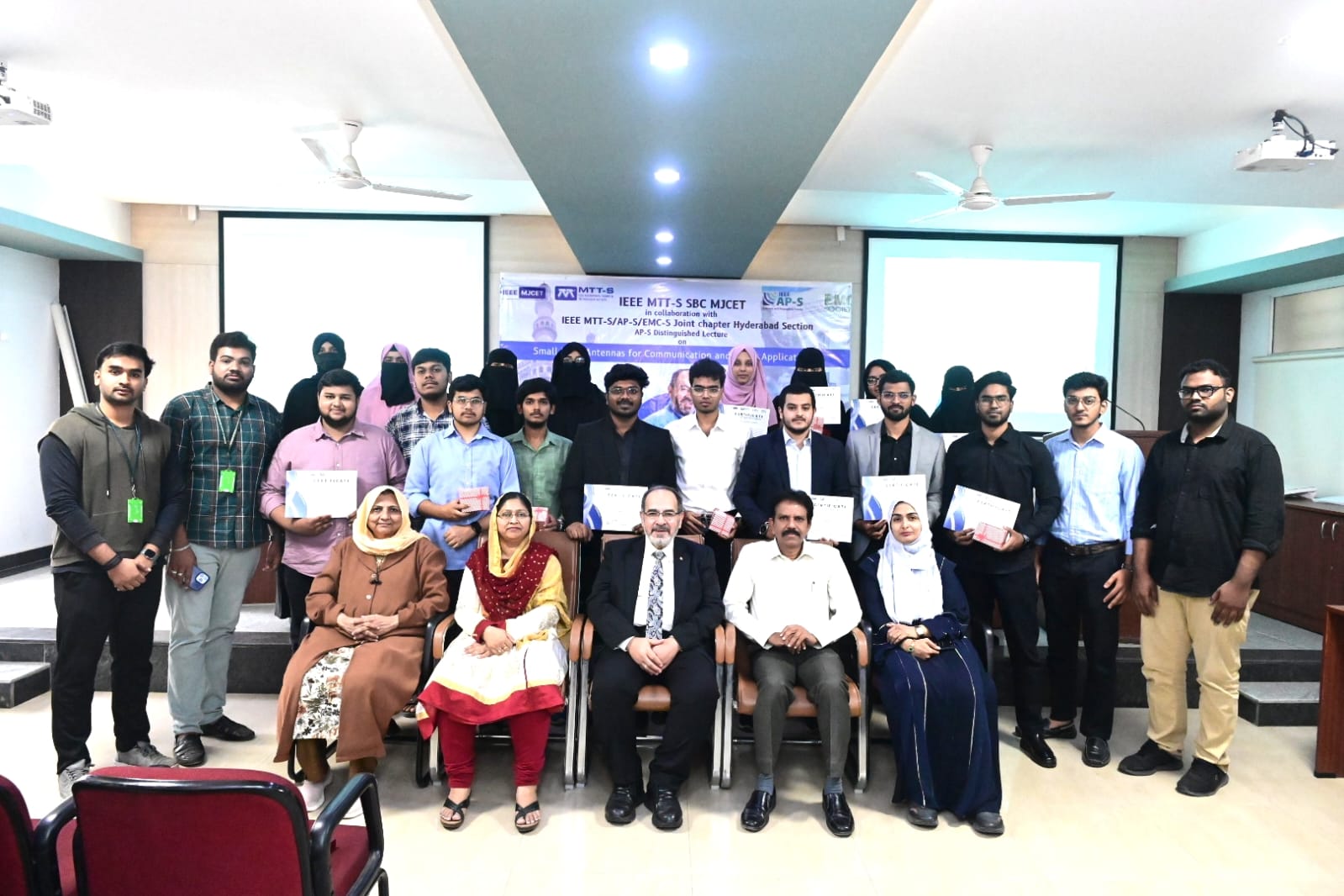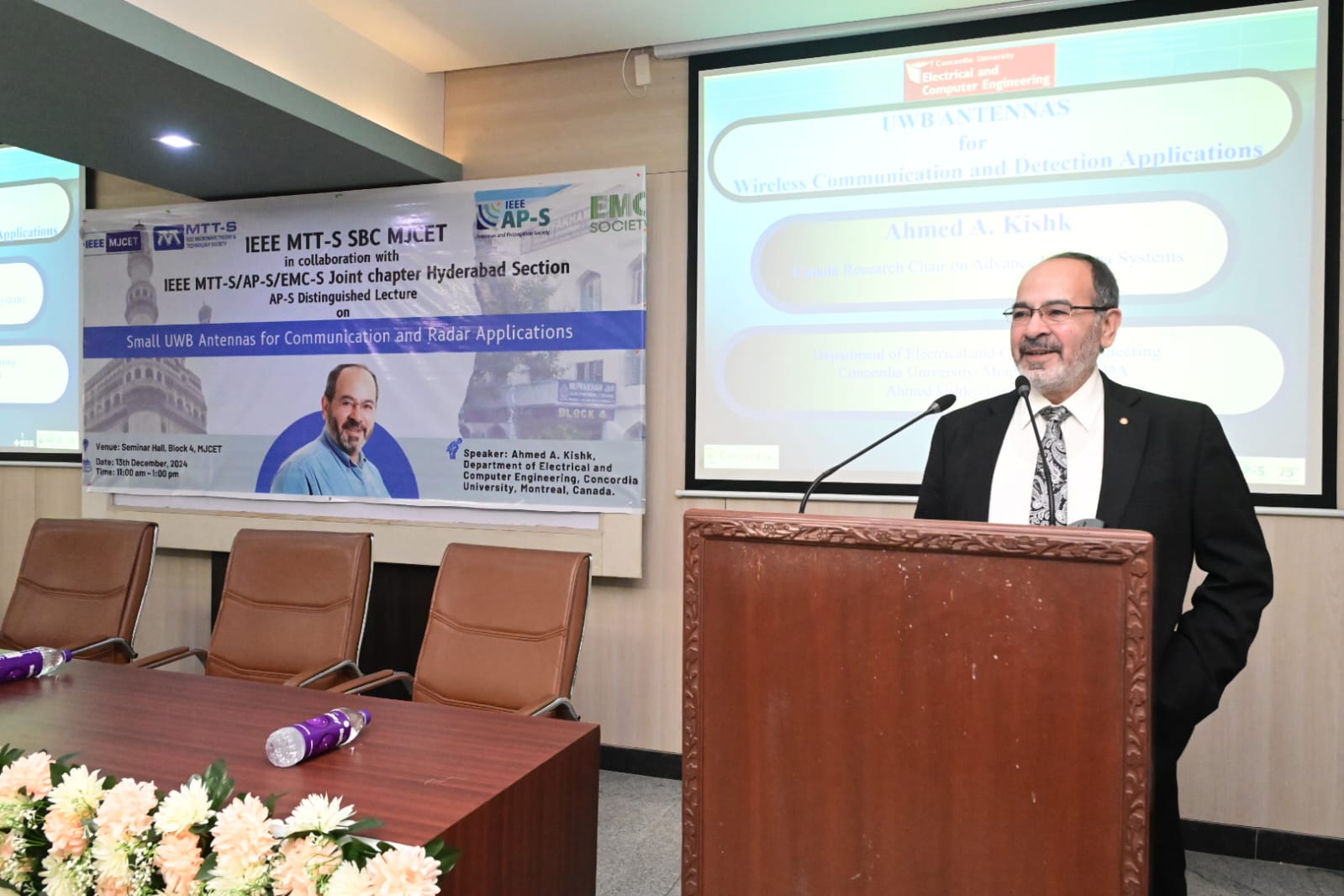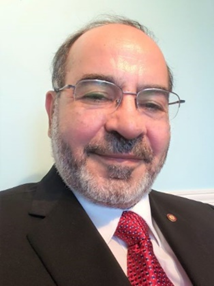Small UWB Antennas for Communication and Radar Applications
IEEE MTT-S SBC MJCET in collaboration with the IEEE MTT-S/AP-S/EMC-S Joint Chapter Hyderabad Section, is thrilled to host an insightful session on "Small UWB Antennas for Communication and Radar Applications."
The IEEE MTT-S MJCET Student Branch Chapter (SBC), in collaboration with the IEEE MTT-S/AP-S/EMC-S Joint Chapter of the IEEE Hyderabad Section, proudly organized an IEEE AP-S Distinguished Lecture at the Seminar Hall of MJCET. The event featured Dr. Ahmed A. Kishk, a globally recognized scholar and distinguished speaker from Canada, who delivered an insightful lecture on "Small UWB Antennas for Communication and Radar Applications." Dr. Kishk's presentation explored state-of-the-art advancements and practical implementations in the field, offering a comprehensive understanding of this critical area of technology. Attendees were provided with a unique opportunity to engage with a leading expert and gain invaluable knowledge. Dr. Kishk's eloquent delivery and profound expertise resonated deeply with the audience, ensuring the session was both intellectually enriching and inspiring. The successful hosting of this distinguished lecture underscores the commitment of IEEE MTTS MJCET SBC to fostering academic excellence and facilitating knowledge exchange in advanced engineering domains.
Date and Time
Location
Hosts
Registration
-
 Add Event to Calendar
Add Event to Calendar
- Seminar Hall
- MuffakhamJah College of Engineering and Technology
- Hyderabad, Telangana, Andhra Pradesh
- India 500034
- Building: Block 4
- Click here for Map
Speakers
Ahmed A. Kishk of Concordia University
Small UWB Antennas for Communication and Radar Applications
A high data rate over short distances requires narrow pulses in the time domain, which is supported by UWB devices in the frequency domain. In the front end, antennas play a major part in affecting the system's performance. Ideally, a transmitting/receiving UWB antenna pair comprises a communication channel that should operate as a band-pass filter covering the UWB band with a flat magnitude response and a linear phase response with frequency. It requires a well-matched UWB antenna with a frequency-independent phase center and linearly increasing gain with frequency over the entire UWB band. An omnidirectional UWB antenna is especially attractive to wireless communications at the base station or terminal. For an omnidirectional UWB antenna, besides the three requirements above, its radiation performance over the UWB band should also be independent of
the azimuth angle. A good impedance matching over the UWB band is not difficult; many antennas can achieve that. The frequency-independent phase center is achievable for most antennas except those with spatially separated multi-resonant structures. But, after the first three requirements are met, wideband omnidirectional radiation is still challenging for UWB antenna design. An omnidirectional UWB antenna with a non-planar conducting structure and DRA is presented for the UWB access point.
Biography:
Ahmed A. Kishk received a BSc in Electronics and Communication Engineering from Cairo University, Cairo, Egypt, in 1977 and a BSc. in Applied Mathematics from Ain-Shams University, Cairo, Egypt, in 1980. In 1981, he joined the Department of Electrical Engineering, University of Manitoba, Winnipeg, Canada, where he obtained his M. Eng. and Ph.D. degrees in 1983 and 1986. From 1977 to 1981, he was a research assistant and an instructor at the Faculty of Engineering at Cairo University. From 1981 to 1985, he was a research assistant at the Department of Electrical Engineering, University of Manitoba. From December 1985 to August 1986, he was a research associate fellow in the same department. In 1986, he joined the Department of Electrical Engineering, University of Mississippi, as an assistant professor. He was on sabbatical leave at the Chalmers University of Technology, Sweden, during the 1994-1995 and 2009-2010 academic years. He was a Professor at the University of Mississippi (1995-2011). He was the director of the Center for Applied Electromagnetic System Research (CAESR) from 2010 to 2011. He has been a professor at Concordia University, Montréal, Québec, Canada (since 2011) and Tier 1 Canada Research Chair in Advanced Antenna Systems. He was an Associate Editor of Antennas & Propagation Society Newsletters from 1990 to 1993. He is a distinguished lecturer for the Antennas and Propagation Society (2013-2015). He was an Editor of Antennas & Propagation Magazine (1993-2014). He was a Coeditor of the special issue, "Advances in the Application of the Method of Moments to Electromagnetic Scattering Problems," in the ACES Journal. He was also an editor of the ACES Journal in 1997. He was an Editor-in-Chief of the ACES Journal from 1990 to 2001. He was the chair of the Physics and Engineering Division of the Mississippi Academy of Science (2001-2002). He was a Guest Editor of the special issue on artificial magnetic conductors, soft/hard surfaces, and other complex surfaces in the IEEE Transactions on Antennas and Propagation, January 2005. He was a co-guest editor for IEEE Antennas and Propagation and Wireless Letter on the Special Cluster on "5G/6G enabling antenna systems and associated testing technologies." He was a technical program committee member for several international conferences. He was a member of the AP-S AdCom (2013-2015). He was the 2017 AP-S president. Prof. Kishk's research interest is broad in Electromagnetic Applications. He has recently worked on millimeter-wave antennas for 5G/6G applications, Analog beamforming networks, Electromagnetic Bandgap, artificial magnetic conductors, soft and hard surfaces, phased array antennas, reflectors/transmitarray, and wearable antennas. In addition, he is a pioneer in Dielectric resonator antennas, microstrip antennas, small antennas, microwave sensors, RFID antennas for readers and tags, Multifunction antennas, microwave circuits, and Feeds for Parabolic reflectors. He has published over 465 refereed journal articles, 550 international conference papers, and 125 local and regional conference papers. He co-authored four books and 13 chapters and was the editor of eight books. He offered several short courses at international conferences. According to Google Scholar, his work was cited over 34959 with an H-index of 80. The bibliometric data for estimating the citation-based metrics were gathered on December 21, 2022. Prof. Kishk was ranked first at Concordia University, 23rd in Canada, and 401 worldwide. ScholarGPS has placed Dr Kishk in the top 0.05% of all scholars worldwide, with # 231 in Electrical Engineering, #4 in Antennas, # 5 in Dielectric, and #78 in Microwave. Prof. Kishk and his students received several awards. He won the 1995 and 2006 outstanding paper awards for papers published in the Applied Computational Electromagnetic Society Journal. He received the Outstanding Engineering Faculty Member of the Year in 1998 and 2009 and the Faculty Research Award for Outstanding Research Performance in 2001 and 2005. He received the Microwave Theory and Techniques Society Microwave Prize in 2004. He received the 2013 Chen-To-Tai Distinguished Educator Award from the IEEE Antennas and Propagation Society. In recognition, "For contributions and continuous improvements to teaching and research to prepare students for future careers in antennas and microwave circuits, Kishk is a Life Fellow of IEEE, Fellow of Electromagnetic Academy, and a Fellow of the Applied Computational Electromagnetics Society (ACES).
Email:
Address:Department of Electrical and Computer Engineering, Concordia University, Montreal, Canada
Media
| WhatsApp_Image_2024-12-13_at_1.41.39_PM | 178.67 KiB | |
| WhatsApp_Image_2024-12-13_at_1.41.38_PM | 180.96 KiB | |
| WhatsApp_Image_2024-12-13_at_1.42.36_PM | 155.92 KiB | |
| WhatsApp_Image_2024-12-13_at_1.42.37_PM | 182.36 KiB |




